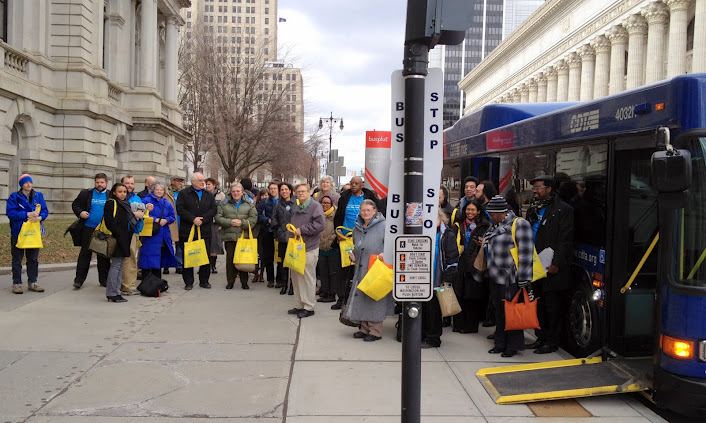
This week in Albany, for the first time ever, a diverse group of transportation advocates—riders, transit operators, laborers, contractors, manufacturers, business owners, and smart growth advocates—spoke in unison: “invest in transit: keep New York moving!”
The New York State Transportation Equity Alliance (NYSTEA) and the New York Public Transit Association collaborated on a two-day transit awareness conference that included a rally and legislative meetings, and the Long Island Lobby Coalition visited Albany to meet with legislators and the Governor’s staff. All three groups asked the legislature to approve Governor Cuomo’s budget, which:
- Proposes no sweeps to dedicated transit revenues, which ensures that increased revenues resulting from a better economy will be fully received by the 135 transit agencies across the state. The healthy funding increase would range from 4.76%-7.69% for downstate systems; upstate systems would see a 6.95% increase.
- Supports the MTA’s 2010-2014 Capital Program and raises the agency’s debt ceiling. This would allow the MTA to complete the last 3 years of its plan.
- Would compensate the MTA for the revenue lost in last year’s payroll mobility tax deal.
- Would redistribute “long lines tax” revenues, which would provide a much-needed dedicated funding stream for non-MTA public transportation systems. The tax is collected statewide, but has historically been deposited into the MTA’s account. Under Governor Cuomo’s proposal, it would be distributed statewide on the basis of population.
The different groups advocated for more than the Governor’s budget, though:
- The Long Island Lobby Coalition asked for a new lockbox bill that would protect the money generated by dedicated transit funding sources. Last year, a lockbox for MTA funds passed the legislature, but the aforementioned tax deal eliminated several key provisions, including a requirement that each transit funding raid be accompanied by a “diversion impact statement” that described its impact on riders.
- The Long Island Lobby Coalition asked for an expansion in red light camera authorization on Long Island, which would allow Suffolk County and Nassau County to double the number of cameras in operation (currently, each county is only authorized to have 50, and the coalition asked them to raise that number to 100). They also requested that any new camera revenue be used to support traffic calming projects, such as the Local Safe Streets and Traffic Calming program and SafeSeniors.
- NYSTEA asked for increased investment in transit and the addition of a rider representative to each of the state’s transit authority boards. This would ensure that riders have a say in the decisions that affect their lives.
The Senate also gave transit advocates something to cheer about by unanimously passing a bill (S2728-c/A6175-b) that gives train and bus commuters a break on their taxes. This will partially compensate for the January 1st reduction of the federal transit commuter tax benefit.

On the issue of red light cameras, would the lights so monitored be required to meet the yellow light timing standards as set forth in the Manual for Uniform Traffic Control Devices or would there be short yellows to increase the number of violations at the expense of safety? Would the camera manufacturers get a percentage of each fine?
[…] advocates support the transit provisions of Governor Cuomo’s budget, Tri-State is calling on Senate Majority Leader […]